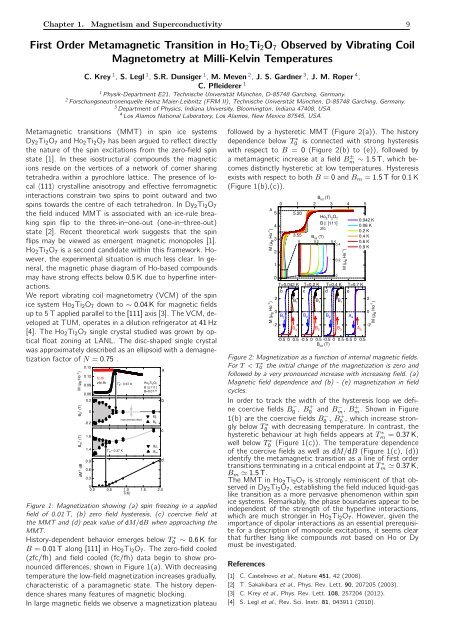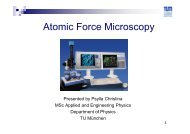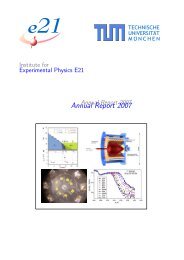Annual Report 2011 / 2012 - E21 - Technische Universität München
Annual Report 2011 / 2012 - E21 - Technische Universität München
Annual Report 2011 / 2012 - E21 - Technische Universität München
Create successful ePaper yourself
Turn your PDF publications into a flip-book with our unique Google optimized e-Paper software.
Chapter 1. Magnetism and Superconductivity 9<br />
First Order Metamagnetic Transition in Ho 2 Ti 2 O 7 Observed by Vibrating Coil<br />
Magnetometry at Milli-Kelvin Temperatures<br />
C. Krey 1 , S. Legl 1 , S.R. Dunsiger 1 , M. Meven 2 , J. S. Gardner 3 , J. M. Roper 4 ,<br />
C. Pfleiderer 1<br />
1 Physik-Department <strong>E21</strong>, <strong>Technische</strong> Universität München, D-85748 Garching, Germany.<br />
2 Forschungsneutronenquelle Heinz Maier-Leibnitz (FRM II), <strong>Technische</strong> Universität München, D-85748 Garching, Germany.<br />
3 Department of Physics, Indiana University, Bloomington, Indiana 47408, USA<br />
4 Los Alamos National Laboratory, Los Alamos, New Mexico 87545, USA<br />
Metamagnetic transitions (MMT) in spin ice systems<br />
Dy 2 Ti 2 O 7 and Ho 2 Ti 2 O 7 has been argued to reflect directly<br />
the nature of the spin excitations from the zero-field spin<br />
state [1]. In these isostructural compounds the magnetic<br />
ions reside on the vertices of a network of corner sharing<br />
tetrahedra within a pyrochlore lattice. The presence of local<br />
〈111〉 crystalline anisotropy and effective ferromagnetic<br />
interactions constrain two spins to point outward and two<br />
spins towards the centre of each tetrahedron. In Dy 2 Ti 2 O 7<br />
the field induced MMT is associated with an ice-rule breaking<br />
spin flip to the three-in–one-out (one-in–three-out)<br />
state [2]. Recent theoretical work suggests that the spin<br />
flips may be viewed as emergent magnetic monopoles [1].<br />
Ho 2 Ti 2 O 7 is a second candidate within this framework. However,<br />
the experimental situation is much less clear. In general,<br />
the magnetic phase diagram of Ho-based compounds<br />
may have strong effects below 0.5 K due to hyperfine interactions.<br />
We report vibrating coil magnetometry (VCM) of the spin<br />
ice system Ho 2 Ti 2 O 7 down to ∼ 0.04K for magnetic fields<br />
up to 5 T applied parallel to the[111] axis [3]. The VCM, developed<br />
at TUM, operates in a dilution refrigerator at 41 Hz<br />
[4]. The Ho 2 Ti 2 O 7 single crystal studied was grown by optical<br />
float zoning at LANL. The disc-shaped single crystal<br />
was approximately described as an ellipsoid with a demagnetization<br />
factor of N = 0.75 .<br />
M (µ B Ho -1 )<br />
B 0<br />
± (T)<br />
B m<br />
± (T)<br />
dM -1 dB<br />
0.15<br />
0.12<br />
0.09<br />
0.06<br />
0.2<br />
0<br />
-0.2<br />
1.6<br />
1.4<br />
0.9<br />
0.6<br />
0.3<br />
fc-fh<br />
zfc-fh<br />
T * m~ 0.37 K<br />
T * 0~ 0.67 K<br />
instrumental offset<br />
Ho 2Ti 2O 7<br />
B || [111]<br />
B=0.01 T<br />
0<br />
0.0 0.5 1.0 1.5 2.0<br />
T(K)<br />
Figure 1: Magnetization showing (a) spin freezing in a applied<br />
field of 0.01 T, (b) zero field hysteresis, (c) coercive field at<br />
the MMT and (d) peak value of dM/dB when approaching the<br />
MMT.<br />
History-dependent behavior emerges below T0 ∗ ∼ 0.6K for<br />
B = 0.01T along [111] in Ho 2 Ti 2 O 7 . The zero-field cooled<br />
(zfc/fh) and field cooled (fc/fh) data begin to show pronounced<br />
differences, shown in Figure 1(a). With decreasing<br />
temperature the low-field magnetization increases gradually,<br />
characteristic of a paramagnetic state. The history dependence<br />
shares many features of magnetic blocking.<br />
In large magnetic fields we observe a magnetization plateau<br />
B + 0<br />
B - 0<br />
B + m<br />
B - m<br />
a<br />
b<br />
c<br />
d<br />
followed by a hysteretic MMT (Figure 2(a)). The history<br />
dependence below T0 ∗ is connected with strong hysteresis<br />
with respect to B = 0 (Figure 2(b) to (e)), followed by<br />
a metamagnetic increase at a field B m ± ∼ 1.5T, which becomes<br />
distinctly hysteretic at low temperatures. Hysteresis<br />
exists with respect to both B = 0 and B m = 1.5T for 0.1 K<br />
(Figure 1(b),(c)).<br />
B int (T)<br />
0 1 2 3 4 5<br />
a<br />
5 5.20<br />
Ho 2 Ti 2 O 7<br />
4<br />
B || [111]<br />
zfc<br />
M (µ B Ho -1 )<br />
M (µ B Ho -1 )<br />
3<br />
2<br />
1<br />
0<br />
2<br />
-2<br />
T=0.042 K<br />
b<br />
0<br />
B 2<br />
3.55 B int (T)<br />
0 0.2 0.4<br />
0.4<br />
B 1<br />
B 3<br />
-0.5 0 0.5<br />
T=0.2 K<br />
c<br />
B 2<br />
B 3<br />
0.2<br />
0<br />
T=0.4 K<br />
d<br />
B 1 B 1<br />
B 2<br />
B 3<br />
M (µ B Ho -1 )<br />
T=0.7 K<br />
e<br />
A 4<br />
0.042 K<br />
0.06 K<br />
0.2 K<br />
0.4 K<br />
0.6 K<br />
0.9 K<br />
A 5<br />
-0.5 0 0.5 -0.5 0 0.5-0.5 0 0.5<br />
B int (T)<br />
Figure 2: Magnetization as a function of internal magnetic fields.<br />
For T < T0 ∗ the initial change of the magnetization is zero and<br />
followed by a very pronounced increase with increasing field. (a)<br />
Magnetic field dependence and (b) - (e) magnetization in field<br />
cycles.<br />
In order to track the width of the hysteresis loop we define<br />
coercive fields B − 0 , B+ 0 and B− m, B m. + Shown in Figure<br />
1(b) are the coercive fields B − 0 , B+ 0 , which increase strongly<br />
below T0 ∗ with decreasing temperature. In contrast, the<br />
hysteretic behaviour at high fields appears at Tm ∗ = 0.37K,<br />
well below T0 ∗ (Figure 1(c)). The temperature dependence<br />
of the coercive fields as well as dM/dB (Figure 1(c), (d))<br />
identify the metamagnetic transition as a line of first order<br />
transitions terminating in a critical endpoint atTm ∗ ≃ 0.37K,<br />
B m ≃ 1.5T.<br />
The MMT in Ho 2 Ti 2 O 7 is strongly reminiscent of that observed<br />
in Dy 2 Ti 2 O 7 , establishing the field induced liquid-gas<br />
like transition as a more pervasive phenomenon within spin<br />
ice systems. Remarkably, the phase boundaries appear to be<br />
independent of the strength of the hyperfine interactions,<br />
which are much stronger in Ho 2 Ti 2 O 7 . However, given the<br />
importance of dipolar interactions as an essential prerequisite<br />
for a description of monopole excitations, it seems clear<br />
that further Ising like compounds not based on Ho or Dy<br />
must be investigated.<br />
References<br />
[1] C. Castelnovo et al., Nature 451, 42 (2008).<br />
[2] T. Sakakibara et al., Phys. Rev. Lett. 90, 207205 (2003).<br />
[3] C. Krey et al., Phys. Rev. Lett. 108, 257204 (<strong>2012</strong>).<br />
[4] S. Legl et al., Rev. Sci. Instr. 81, 043911 (2010).<br />
2<br />
0<br />
-2<br />
M (µ B Ho -1 )




